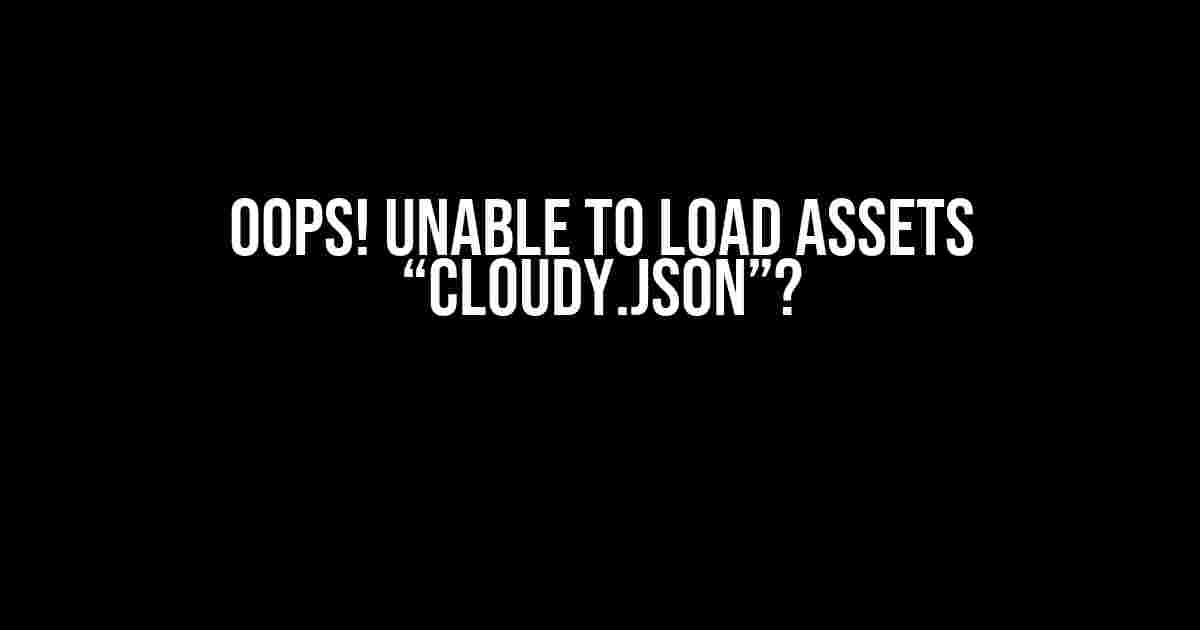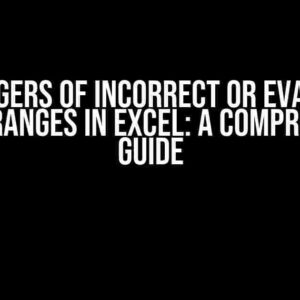If you’re reading this, chances are you’ve stumbled upon the frustrating error message “Unable to load assets ‘cloudy.json’ (The asset does not exist or has empty data)”. Don’t worry, friend! You’re in the right place. In this article, we’ll dive into the whys and hows of this pesky error, and more importantly, provide you with a step-by-step guide to resolve it.
What is the “cloudy.json” file?
Before we dive into the solution, let’s take a quick detour to understand what the “cloudy.json” file is. In simple terms, “cloudy.json” is an asset file that contains data in a JSON (JavaScript Object Notation) format. This file is often used in game development, data visualization, and other applications that require storing and retrieving data.
Why does the error occur?
So, why does the error “Unable to load assets ‘cloudy.json’ (The asset does not exist or has empty data)” occur in the first place? There are several reasons for this, including:
- MISSING FILE: The most common reason is that the “cloudy.json” file is simply not present in the expected location.
- EMPTY DATA: The file exists, but it’s empty or contains invalid data.
- PERMISSION ISSUES: The file or folder may have incorrect permissions, preventing the application from accessing it.
- PATH ISSUES: The file path is incorrect or has been misconfigured.
- DEPENDENCY ISSUES: The application or library relying on “cloudy.json” may have issues with its dependencies.
Resolving the “cloudy.json” Error
Now that we’ve covered the whys, let’s get to the hows! Follow these step-by-step instructions to resolve the error:
Step 1: Verify the File Existence
First things first, check if the “cloudy.json” file exists in the expected location. If it doesn’t, you can:
- Check your project’s file structure and ensure the file is in the correct location.
- Create a new “cloudy.json” file in the correct location, if it’s missing.
Step 2: Check File Permissions
If the file exists, ensure that it has the correct permissions. You can:
- Right-click the file and check its properties to verify the permissions.
- Adjust the permissions to ensure the application has read access to the file.
Step 3: Verify File Content
Next, check the contents of the “cloudy.json” file. If it’s empty or contains invalid data:
- Open the file in a text editor and verify its contents.
- Ensure the file contains valid JSON data.
- If the file is empty, populate it with the required data.
Step 4: Check File Path
If the file exists and has correct permissions, ensure the file path is correct. You can:
- Check the application’s configuration files for any misconfigured paths.
- Verify the file path in your code, if you’re using a custom implementation.
Step 5: Resolve Dependency Issues
If the error persists, it’s possible that there are issues with the dependencies. You can:
- Check the application’s dependencies and ensure they’re up-to-date.
- Verify that the dependencies are compatible with each other.
Bonus Tips and Tricks
To avoid future occurrences of this error, consider the following:
- USE A VERSION CONTROL SYSTEM: Implement a version control system like Git to track changes to your files and prevent data loss.
- VALIDATE USER INPUT: Validate user input to prevent data corruption and ensure that the “cloudy.json” file contains valid data.
- REGULARLY BACKUP YOUR DATA: Regularly backup your data to prevent data loss in case of unexpected errors or system failures.
Conclusion
There you have it! With these steps, you should be able to resolve the “Unable to load assets ‘cloudy.json’ (The asset does not exist or has empty data)” error. Remember to stay calm, patient, and methodical in your approach. If you’re still stuck, feel free to ask for help in the comments below.
Code Snippet:
// Example code snippet to load the "cloudy.json" file
const jsonData = require('./cloudy.json');
if (!jsonData) {
console.error(' Unable to load assets "cloudy.json" ');
} else {
console.log(' Successfully loaded "cloudy.json"!');
// Process the JSON data
}
| Error Cause | Solution |
|---|---|
| Missing File | Create the file or verify its existence |
| Empty Data | Populate the file with valid JSON data |
| Permission Issues | Adjust file permissions to ensure read access |
| Path Issues | Verify and correct the file path |
| Dependency Issues | Resolve dependency issues and ensure compatibility |
By following these steps and tips, you’ll be well on your way to resolving the “Unable to load assets ‘cloudy.json’ (The asset does not exist or has empty data)” error. Happy coding!
Here are 5 Questions and Answers about “Unable to load assets "cloudy.json" (The asset does not exist or has empty data)” in a creative voice and tone:
Frequently Asked Questions
Get the answers to your burning questions about that pesky “cloudy.json” error!
Q1: What does the “Unable to load assets "cloudy.json" error mean?
Don’t worry, it’s not a rainy day! This error message simply means that your app is trying to load a file called “cloudy.json” but can’t find it or the file is empty.
Q2: Why can’t my app find the “cloudy.json” file?
There are a few reasons why this might happen. Maybe the file was deleted or renamed, or maybe it was never created in the first place! Double-check your file structure and make sure everything is in its right place.
Q3: How do I fix the “cloudy.json” error?
Easy peasy! Just create a new file called “cloudy.json” in the right directory, or restore the original file if you’ve deleted it. Make sure the file isn’t empty, and you’re good to go!
Q4: Can I ignore the “cloudy.json” error and just continue building my app?
We wouldn’t recommend it! The “cloudy.json” file is probably required for your app to function properly, so ignoring the error might cause more problems down the line. Fix the error first, and then continue building your app.
Q5: Is the “cloudy.json” error a common problem?
You’re not alone! The “cloudy.json” error is a pretty common issue, especially for developers who are new to working with JSON files. So take a deep breath, follow the fixes above, and you’ll be back on track in no time.
I hope this helps!


